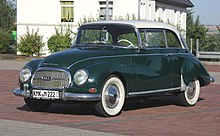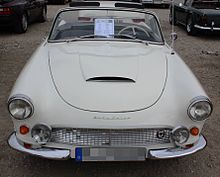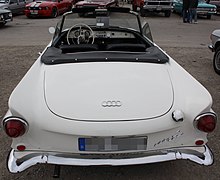Auto Union 1000
| Auto Union | |
|---|---|
|
Auto Union 1000 (YOC 1958)
|
|
| 1000 | |
| Production period: | 1958-1963 |
| Class : | Lower middle class |
| Body versions : | Sedan , station wagon , coupé , convertible |
| Engines: |
Otto engine : 1.0 liter (32-40 kW) |
| Length: | 4170-4325 mm |
| Width: | 1640-1695 mm |
| Height: | 1325-1565 mm |
| Wheelbase : | 2350-2450 mm |
| Empty weight : | 930-970 kg |
| Previous model | DKW F94 |
| successor | DKW F102 |
The Auto Union 1000 is a lower middle class passenger car with a three - cylinder two-stroke engine and front-wheel drive . It is the successor to the “Big DKW 3 = 6” ( F93 / 94 ) and the only Auto Union passenger car with the manufacturer's name as a brand instead of DKW . In August 1963, the DKW F 102 followed as the last West German production car with a two-stroke engine.
Auto Union 1000/1000 S.
The Auto Union 1000 largely corresponded to the DKW 3 = 6 (F93 / F94) . The main differences were the more powerful engine with more displacement (981 cm³) and the four rings on the outside of the radiator grille as well as the "Auto Union" logo instead of the DKW trademark on the bonnet. It was available as a four- and two-door sedan with front hinged doors and as a four-seater coupé without a B-pillar . For the 1960 model year (from August 1959) the two-door sedan and the four-seater Auto Union 1000 S coupe were given a panoramic windscreen . In 1961, the radiator grille was redesigned with vertical decorative bars. The station wagon known as Universal was produced from 1959 to 1963.
The vehicles had a box section frame and an all-steel body. At the front, the wheels were individually suspended from lower wishbones and an overhead transverse leaf spring. At the rear, the floating axle known from its predecessors was installed. On request, the vehicles were also available with the fully automatic “ Saxomat ” centrifugal clutch .
Between January 1958 and July 1963, Auto Union produced 171,008 sedans and coupés of the Auto Union 1000 and 1000 S types at the Düsseldorf-Derendorf plant . From August 1959 a station wagon was added under the name "Universal", which sold 16,421 units by November 1962. times was sold. The highlight of the series was the Auto Union 1000 S Coupé de Luxe with disc brakes . In 1962, however, only 18,085 Auto Union 1000s were manufactured.
In the 1961/62 model year, Auto Union introduced two-stroke separate lubrication using the “fresh oil automatic” developed jointly with Bosch . The system with a separate oil tank and oil pump was supposed to make it possible to refuel with petrol without the addition of oil, because petrol stations with a two-stroke mixture became less common. In 1956, the mixing ratio had already been reduced from 1:25 to 1:40, and the engine could now be operated at 1:60 at full load and at 1: 400 when idling. According to advertising, the new system should above all guarantee a longer engine life, which was not achieved in practice. In the extremely cold winter of 1962/63 , an unusually large amount of crankshaft damage occurred because the oil, which is viscous at low temperatures, was not transported sufficiently through the thin line into the carburetor.
After production in Germany ended in mid-1963, the Auto Union 1000 S was manufactured by Veículos e Máquinas Agrícolas in São Paulo (Brazil) with minor retouching and in Santa Fe (Argentina) without changes until 1967.
Around 1963, Peter Maier-Asboe (1938–1986) , who was then based in Berlin, designed a four-seater coupé with a plastic body based on the AU 1000 S as an alternative to the AU 1000 Sp. It is unclear whether or not there was a small (very) series in 1964 the vehicle remained a one-off.
Auto Union 1000 Sp
The Auto Union 1000 Sp (Sp for special and not, as is often assumed, for the word "sport") was a two-seater sports coupe or a two-seater roadster.
The 1000 SP was presented at the IAA in 1957 and was manufactured by Baur in Stuttgart from 1958 to 1965 . It reached a number of 5004 coupes. From September 1961 to April 1965, 1640 open roadsters were also produced.
Compared to the Auto Union 1000 S, the engine output was increased to 41 kW (55 PS) mainly through higher compression (8: 1), but also through minor differences in the engine block and different carburetor systems. This brought the “narrow-gauge Thunderbird ”, as the 1000 Sp was occasionally called in the press, to a top speed that, at 140 km / h, slightly exceeded the less powerful 1000 S Coupé.
From the 62 models onwards, both the Coupé and the Roadster received rounded side fins. Subsequently (from chassis number 4.360 / March 1962) there were also disc brakes on the front axle and the fresh oil automatic. Like the other models, the AU 1000 Sp also has sheet metal reinforcements for the attachment of seat belts. With the use of the automatic fresh oil system, the 32/36 NDIX double carburetor was replaced by the Solex downdraft carburetor 40 CIB.
Coupé and Roadster cost 11,950 DM when they were launched, later the price was lowered to 10,950 DM and most recently, in early 1965, to 9,400 DM.
Technical specifications
| Type | AU 1000 Coupé | AU 1000 four-door | AU 1000 Sp | AU 1000 Universal | AU 1000 S Coupé | AU 1000 S four-door |
|---|---|---|---|---|---|---|
| Construction period | 1957-1960 | 1957-1960 | 1958-1965 | 1959-1963 | 1959-1963 | 1961-1963 |
| Superstructures | L2, Cp2 | L4 | Cp2, Cb2 | K3 | L2, Cp2 | L4 |
| engine | 3 cyl. Row, 2-stroke | 3 cyl. Row, 2-stroke | 3 cyl. Row, 2-stroke | 3 cyl. Row, 2-stroke | 3 cyl. Row, 2-stroke | 3 cyl. Row, 2-stroke |
| Bore × stroke | 74 mm × 76 mm | 74 mm × 76 mm | 74 mm × 76 mm | 74 mm × 76 mm | 74 mm × 76 mm | 74 mm × 76 mm |
| Displacement | 981 cc | 981 cc | 981 cc | 981 cc | 981 cc | 981 cc |
| Power kW (PS) | 32.3 (44) | 32.3 (44) | 40 (55) | 32.3 (44) | 37 (50) | 37 (50) |
| at speed (1 / min) | 4500 | 4500 | 4500 | 4500 | 4500 | 4500 |
| Torque (Nm) | 78.5 | 78.5 | 88.3 | 78.5 | 78.5 | 78.5 |
| at speed (1 / min) | 3000 | 3000 | 3500 | 3000 | 3000 | 3000 |
| compression | 7.25: 1 | 7.25: 1 | 8.2: 1 | 7.25: 1 | 7.25: 1 | 7.25: 1 |
| consumption | 10 l / 100 km | 10.5 l / 100 km | 10.5 l / 100 km | 10.5 l / 100 km | 10 l / 100 km | 10.5 l / 100 km |
| transmission | 4-speed with freewheel and steering wheel shift / up to models 1960 1st gear not synchronized | |||||
| Top speed | 130 km / h | 120 km / h | 140 km / h | 120 km / h | 135 km / h | 125 km / h |
| Empty weight | 930 kg | 970 kg | 960 kg | 950 kg | 930 kg | 970 kg |
| Perm. total weight | 1305 kg | 1350 kg | 1200 kg | 1455 kg | 1305 kg | 1350 kg |
| Electrics | 6 volts | 6 volts | 6 volts | 6 volts | 6 volts | 6 volts |
| length | 4225 mm | 4325 mm | 4170 mm | 4210 mm | 4225 mm | 4325 mm |
| width | 1695 mm | 1695 mm | 1680 mm | 1640 mm | 1695 mm | 1695 mm |
| height | 1465 mm | 1490 mm | 1325 mm | 1565 mm | 1465 mm | 1490 mm |
| wheelbase | 2350 mm | 2450 mm | 2350 mm | 2450 mm | 2350 mm | 2450 mm |
| Front / rear track | 1290 mm / 1350 mm | 1290 mm / 1350 mm | 1290 mm / 1350 mm | 1290 mm / 1350 mm | 1290 mm / 1350 mm | 1290 mm / 1350 mm |
| Turning circle | 11.7 m | 12 m | 11.5 m | 12 m | 11.7 m | 12 m |
| wheel size | 5.60-15 ″ | 5.60-15 ″ | 155 SR 15 | 6.00-15 " | 5.60-15 ″ | 5.60-15 ″ |
An electro-pneumatic coupling ( Saxomat ) was available on request .
- L2 = 2-door sedan
- L4 = 4-door sedan
- Cp2 = 2-door coupé
- Cb2 = 2-door convertible
- K3 = 3-door station wagon
Literature and Sources
- Siegfried Rauch: DKW - The story of a global brand. Motorbuch Verlag, Stuttgart 1988, ISBN 3-87943-759-9 .
- Peter Kurz: DKW master class. Delius Klasing Verlag, Bielefeld 2005, ISBN 3-7688-1646-X .
- Werner Oswald: German Cars 1945–1990. Volume 4, 1st edition, Motorbuch Verlag, Stuttgart 2001, ISBN 3-613-02131-5 .
- car, motor and sport. Issue 17/1958.
- Motor Revue. Issue 39, autumn edition 1961, Vereinigte Motorverlage, Stuttgart.
- Brochure WB - 3652 (800 - H - 122) from Auto Union DKW.
Individual evidence
- ↑ Auto Union (Ed.): List of chassis and engine numbers WB6277 . 1966.
- ↑ Death of a Saxony , Der Spiegel 33/1963, p. 57 f.
- ↑ Flag deleted , Der Spiegel 42/1961, p. 95
- ↑ DKW Practice T1-004 WB 2568 .
- ↑ DKW Practice T-009 . 4th September 1961.
- ↑ DKW Practice T1-009 . July 18, 1962.











